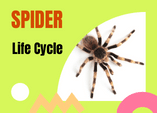S
pider Life Cycle Game Online
The Life Cycle Of a spider Game Online. Biology lesson for students from 2nd to 7th grades to learn the stages in the life cycle of a spider.

A spider undergoes an incomplete metamorphosis, meaning that it only goes three three distinct stages from egg, nymph to adulthood. The life cycle of a spider begins when a female lays an egg. After the egg has been laid, a spiderling hatches. The baby spider looks like a small adult, but is actually much smaller. Most spiderlings live with their mother for a few weeks, but some will leave the sac to develop on their own. Then the baby spiders grow up and become adults, but they are still vulnerable until they get an exoskeleton.
As mentioned earlier, the life cycle of a spider consists of three stages. The egg sacs of female spiders can contain as many as four to 600 eggs. The mother constructs an egg sac out of strong silk and fertilizes the eggs as they are laid. Once the eggs hatch, the spiderlings are ready to eat. The baby spiders typically take a few weeks to hatch out of their egg sac.
After the egg sac hatches, the spiderling molts five to ten times. After the last molt, the adult spider is ready to reproduce and transfer the sperm to the palpal bulb. The male spider also performs a series of courtship rituals to attract a female of the same species. The rituals vary with species, but they usually involve vibrational patterns in the web and touching the female's body.
Once the egg sac is developed, the female spider stores sperm until she is ready to produce eggs. The egg sac is constructed by the mother and a male spider fertilizes the eggs in it.
The life cycle of a spider is a fascinating process given that the female spider will store sperm until she is ready to lay her eggs. When it is ready to lay eggs, the female will store spermatophores in the egg sac and fertilize the eggs on its own. Female spiders are known in some instances to eat their male counterparts after mating. This makes spiders carnivores.
If you want to practice the stages in a spider’s life cycle, click on the start button in the game above and begin practicing. This game is for biology students in the classroom or at home. Tell us what your experience was using this game.
About Spiders :
The most common type of spider is the house spider. These arthropods have eight legs and chelicerae with fangs. They are known for their venom and spinnerets, which extrude silk. The largest order of arachnids, spiders rank seventh in total species diversity. They have evolved from ancient times and are now widespread throughout the world. The most common type of house, or garden, or barn-spider, is the black widow.
The evolution of spiders is still unknown, but it's worth looking at some of the most interesting species. They have varying body types and behaviors. Some are much larger and more robust than others. Their anatomy is unique, making them scarier than other animals. They are classified according to the size of their head and body, and their eyes and legs are quite small.
The structure of the spider is complex, but it's still important to know about it. The body of a spider consists of a rigid exoskeleton that is filled with blood and is surrounded by bristles. The pressure of blood in the spider's body is varied based on the frequency of its heartbeat and the contraction and relaxation of its muscles. The exoskeleton helps keep the body shaped and functioning. Check out a worksheet on labeling a spider to learn more about them.
